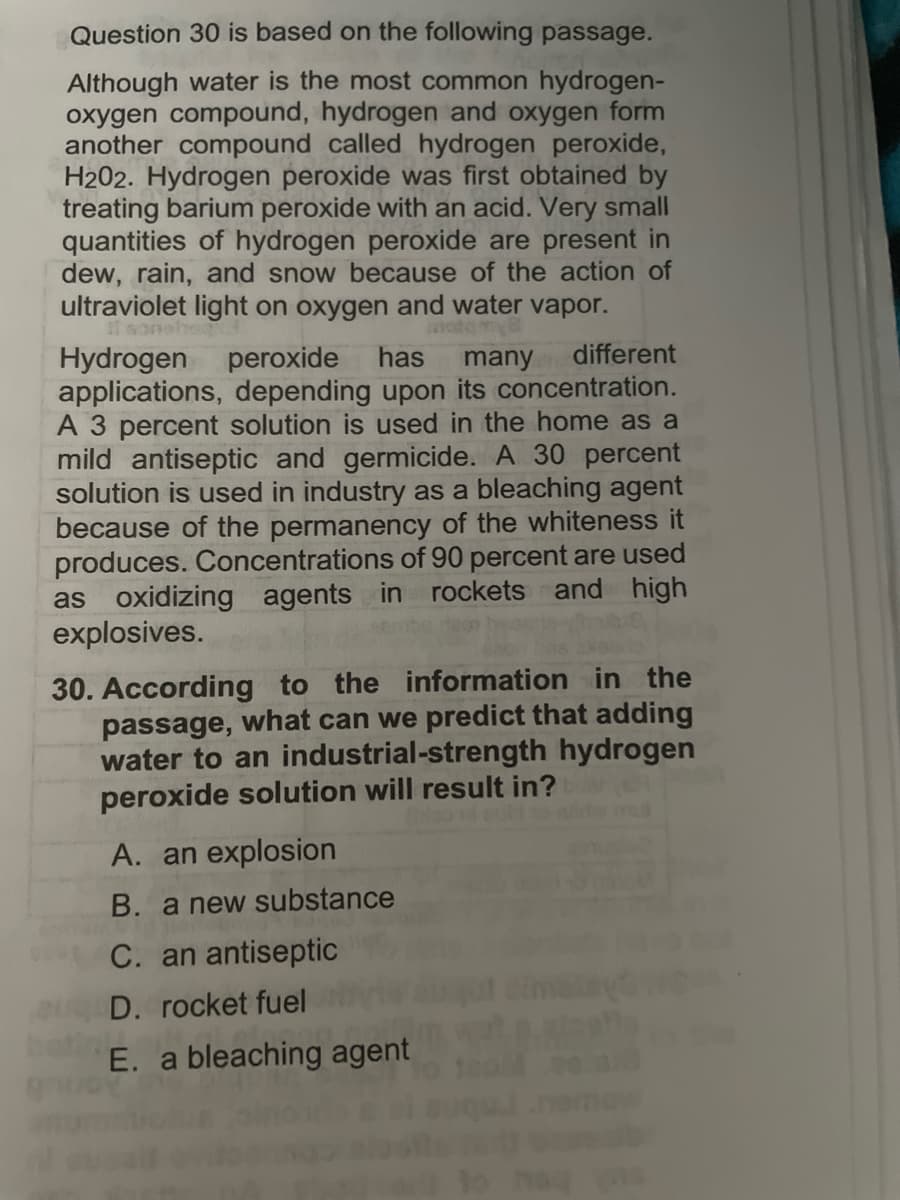another compound called hydrogen peroxide, H202. Hydrogen peroxide was first obtained by treating barium peroxide with an acid. Very small quantities of hydrogen peroxide are present in dew, rain, and snow because of the action of ultraviolet light on oxygen and water vapor. different Hydrogen applications, depending upon its concentration. A 3 percent solution is used in the home as a mild antiseptic and germicide. A 30 percent solution is used in industry as a bleaching agent pecause of the permanency of the whiteness it produces. Concentrations of 90 percent are used as oxidizing agents in rockets and high explosives. peroxide has many 30. According to the information in the passage, what can we predict that adding on industrial-strenath hydrogen
another compound called hydrogen peroxide, H202. Hydrogen peroxide was first obtained by treating barium peroxide with an acid. Very small quantities of hydrogen peroxide are present in dew, rain, and snow because of the action of ultraviolet light on oxygen and water vapor. different Hydrogen applications, depending upon its concentration. A 3 percent solution is used in the home as a mild antiseptic and germicide. A 30 percent solution is used in industry as a bleaching agent pecause of the permanency of the whiteness it produces. Concentrations of 90 percent are used as oxidizing agents in rockets and high explosives. peroxide has many 30. According to the information in the passage, what can we predict that adding on industrial-strenath hydrogen
Chemistry
10th Edition
ISBN:9781305957404
Author:Steven S. Zumdahl, Susan A. Zumdahl, Donald J. DeCoste
Publisher:Steven S. Zumdahl, Susan A. Zumdahl, Donald J. DeCoste
Chapter20: The Representative Elements
Section: Chapter Questions
Problem 110CP
Related questions
Question
Please help

Transcribed Image Text:Question 30 is based on the following passage.
Although water is the most common hydrogen-
oxygen compound, hydrogen and oxygen form
another compound called hydrogen peroxide,
H202. Hydrogen peroxide was first obtained by
treating barium peroxide with an acid. Very small
quantities of hydrogen peroxide are present in
dew, rain, and snow because of the action of
ultraviolet light on oxygen and water vapor.
different
Hydrogen
applications, depending upon its concentration.
A 3 percent solution is used in the home as a
mild antiseptic and germicide. A 30 percent
solution is used in industry as a bleaching agent
because of the permanency of the whiteness it
produces. Concentrations of 90 percent are used
as oxidizing agents in rockets and high
explosives.
peroxide has
many
30. According to the information in the
passage, what can we predict that adding
water to an industrial-strength hydrogen
peroxide solution will result in?
A. an explosion
B. a new substance
C. an antiseptic
D. rocket fuel
E. a bleaching agent
Expert Solution
This question has been solved!
Explore an expertly crafted, step-by-step solution for a thorough understanding of key concepts.
Step by step
Solved in 2 steps with 2 images

Knowledge Booster
Learn more about
Need a deep-dive on the concept behind this application? Look no further. Learn more about this topic, chemistry and related others by exploring similar questions and additional content below.Recommended textbooks for you

Chemistry
Chemistry
ISBN:
9781305957404
Author:
Steven S. Zumdahl, Susan A. Zumdahl, Donald J. DeCoste
Publisher:
Cengage Learning


Principles of Modern Chemistry
Chemistry
ISBN:
9781305079113
Author:
David W. Oxtoby, H. Pat Gillis, Laurie J. Butler
Publisher:
Cengage Learning

Chemistry
Chemistry
ISBN:
9781305957404
Author:
Steven S. Zumdahl, Susan A. Zumdahl, Donald J. DeCoste
Publisher:
Cengage Learning


Principles of Modern Chemistry
Chemistry
ISBN:
9781305079113
Author:
David W. Oxtoby, H. Pat Gillis, Laurie J. Butler
Publisher:
Cengage Learning

Chemistry by OpenStax (2015-05-04)
Chemistry
ISBN:
9781938168390
Author:
Klaus Theopold, Richard H Langley, Paul Flowers, William R. Robinson, Mark Blaser
Publisher:
OpenStax

Chemistry: Principles and Practice
Chemistry
ISBN:
9780534420123
Author:
Daniel L. Reger, Scott R. Goode, David W. Ball, Edward Mercer
Publisher:
Cengage Learning

World of Chemistry, 3rd edition
Chemistry
ISBN:
9781133109655
Author:
Steven S. Zumdahl, Susan L. Zumdahl, Donald J. DeCoste
Publisher:
Brooks / Cole / Cengage Learning